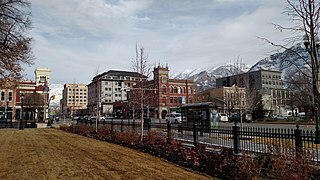
Provo is a city in and the county seat of Utah County, Utah, United States. It is 43 miles (69 km) south of Salt Lake City along the Wasatch Front, and lies between the cities of Orem to the north and Springville to the south. With a population at the 2020 census of 115,162, Provo is the fourth-largest city in Utah and the principal city in the Provo-Orem metropolitan area, which had a population of 526,810 at the 2010 census. It is Utah's second-largest metropolitan area after Salt Lake City.

The Utah Territorial Statehouse, officially Territorial Statehouse State Park Museum, is a state park in Fillmore, Utah. The museum and park preserves the original seat of government for Utah Territory before the capital was moved to Salt Lake City in 1856. Built from 1852 to 1855, the statehouse was initially intended as a larger structure, but only the south wing was completed before the project was abandoned due to lack of federal funding. After its construction, the Utah Territorial Legislative Assembly met in the building for only one full session and parts of two others.
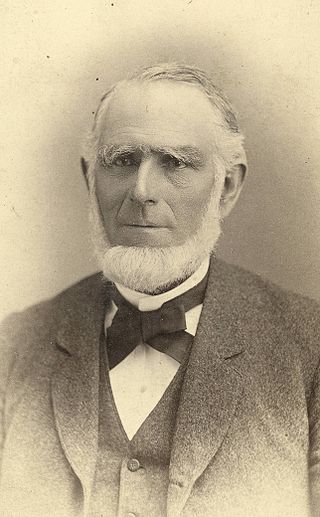
Abraham Owen Smoot was an American pioneer, businessman, religious leader, and politician. He spent his early life in the Southern United States and was one of seven children. After being baptized a member of the Church of Christ, predecessor to the Church of Jesus Christ of Latter-day Saints, Smoot served as a missionary in Kentucky, Tennessee, South Carolina, and England. He received no formal education, but learned to read as a child and later attended the School of the Prophets in Kirtland, Ohio. Like other early members of the LDS Church, Smoot practiced plural marriage, eventually marrying six women and having 24 children. After migrating west to Utah Territory, he was elected as the second mayor of Salt Lake City and maintained this position from 1857 to 1866. He was then assigned by Brigham Young to move to Provo, where he served as stake president and mayor from 1868 to 1881. He assisted financially in the construction of the Provo Tabernacle—today the Provo City Center Temple—as well as that of the Utah Southern Railroad. Smoot was the first president of the board of trustees of Brigham Young Academy (BYA)—which later developed into Brigham Young University (BYU). He was an early financial supporter of the institution and was nicknamed the "foster father" of the academy. His goal was to make education available to young Latter-day Saints. Today, the Smoot Administration Building at BYU is named after him.
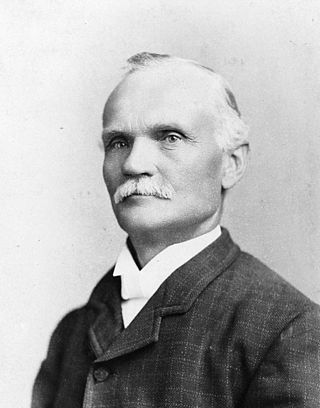
Karl Gottfried Maeser was a prominent Utah educator and a member of the Church of Jesus Christ of Latter-day Saints. He served 16 years as principal of Brigham Young Academy. Although he was not the first principal of the Academy, he is considered its founder. The Academy later became Brigham Young University (BYU) in 1903.

Warren Newton Dusenberry was the founding principal of Brigham Young Academy in 1876. Before becoming principal of Brigham Young Academy, Dusenberry was the founder of three other schools in Provo, Utah. Dusenberry was only a temporary principal and was succeeded by Karl G. Maeser. He also served as County Judge of Utah County and mayor of Provo.

Brigham Young College was a college and high school in Logan, Utah. It was founded by Brigham Young on 6 August 1877, 23 days before his death. He deeded several acres of land to a board of trustees for the development of a college. This was just two years after he founded Brigham Young Academy in Provo in 1875, which became Brigham Young University in 1903.
Mary Ellen Wood Smoot was the thirteenth Relief Society General President of the Church of Jesus Christ of Latter-day Saints from 1997 to 2002.
Fred Lewis Markham was an American architect in the early 20th century who designed movie theatres and many buildings on the campus of Brigham Young University (BYU) in Provo, Utah.
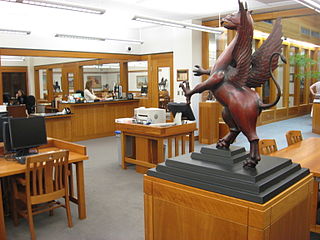
The L. Tom Perry Special Collections is the special collections department of Brigham Young University (BYU)'s Harold B. Lee Library in Provo, Utah. Founded in 1957 with 1,000 books and 50 manuscript collections, as of 2016 the Library's special collections contained over 300,000 books, 11,000 manuscript collections, and over 2.5 million photographs, among many other rare and unique research materials. Since its inception, the special collections have been housed in numerous places including the crawl space of a university building and a wholesale grocery warehouse. Since 2016, the special collections have been located on the first floor of the Harold B. Lee Library and is considered to hold "the finest collection of rare books in the Intermountain West and the second finest Mormon collection in existence".

Harvey Harris Cluff (1836–1916) was a business, civic and educational leader in late-19th-century Provo, Utah.
R. Don Cook is the organ area coordinator and the university carillonneur at Brigham Young University (BYU).

The Provo Tabernacle was a tabernacle of the Church of Jesus Christ of Latter-day Saints from 1898 to 2010 in downtown Provo, Utah, United States. It was a historic icon of Provo and had been home to many religious and cultural events. All but the outer walls of the building were destroyed by fire in December 2010. The LDS Church preserved the remaining outer walls and built a new foundation and interior as part of the Provo City Center Temple, completed in 2016.

Brigham Young High School was a private high school in Provo, Utah, United States, first known as Brigham Young Academy (BYA). The school later became attached to Brigham Young University (BYU) with its official name being Brigham Young University High School, commonly called B Y High. It operated under the Church Educational System of the Church of Jesus Christ of Latter-day Saints.
Richard Charles Watkins, an immigrant from Bristol, England, was an American architect throughout the intermountain west in the late 19th and early 20th centuries. In his early career, he interned with Richard K.A. Kletting in Salt Lake City. In 1890, he came to Provo, Utah as a construction supervisor, and opened his own firm in 1892. When he left nearly 20 years later he had become the most prominent architect south of Salt Lake City, Utah. His works include designing over 240 schools in the intermountain west of the United States including. He served as the architect for Utah State Schools between 1912 and 1920. He also designed businesses, courthouses, eight Carnegie libraries, churches and homes. A number of his buildings survive and are listed on the U.S. National Register of Historic Places.
Brigham Roland Smoot was a missionary of the Church of Jesus Christ of Latter-day Saints and an executive of the Utah-Idaho Sugar Company. He was one of the two first Mormon missionaries to preach in Tonga and served as president of the LDS Church's Tongan mission from July 1891 to October 1892. Smoot was the son of Abraham O. Smoot and the brother of Reed Smoot.

Ida Maline Smoot Dusenberry was a Utah educator and a leader in the Relief Society of the Church of Jesus Christ of Latter-day Saints.
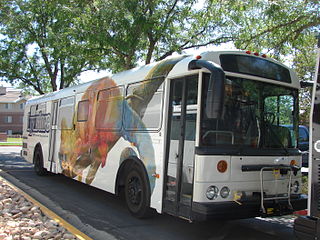
The Ryde is a bus service that provides transportation to the Brigham Young University (BYU) community in Provo, Utah, United States. The service is owned and operated by Student Movement, Inc. (SMI) and operates under the brand, "The Ryde". Although The Ryde began as a limited service paid shuttle bus, in the fall of 2015 it expanded to limited-service bus routes that are free to BYU students.
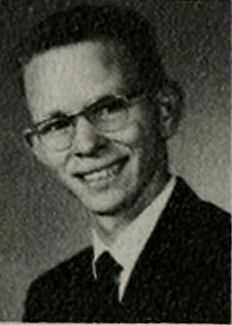
Leon Douglas Smoot was an American chemical engineering professor and researcher. He was most noted for his work in aerospace and rocket propulsion and later his work on fossil fuels and energy. Smoot worked in various capacities at Brigham Young University for over 35 years, and consulted with over sixty companies and agencies for energy and combustion throughout the United States and Europe. He was a member of American Institute of Chemical Engineers, American Society for Engineering Education, The Combustion Institute, and National Fire Protection Association and authored or co-authored over 200 articles and 4 books on the topic on energy and propulsion.

The Harold B. Lee Library (HBLL) is the main academic library of Brigham Young University (BYU) located in Provo, Utah. The library started as a small collection of books in the president's office in 1876 before moving in 1891. The Heber J. Grant Library building was completed in 1925, and in 1961 the library moved to the newly constructed J. Reuben Clark Library where it stands today. That building was renamed to the Harold B. Lee Library in 1974.


















